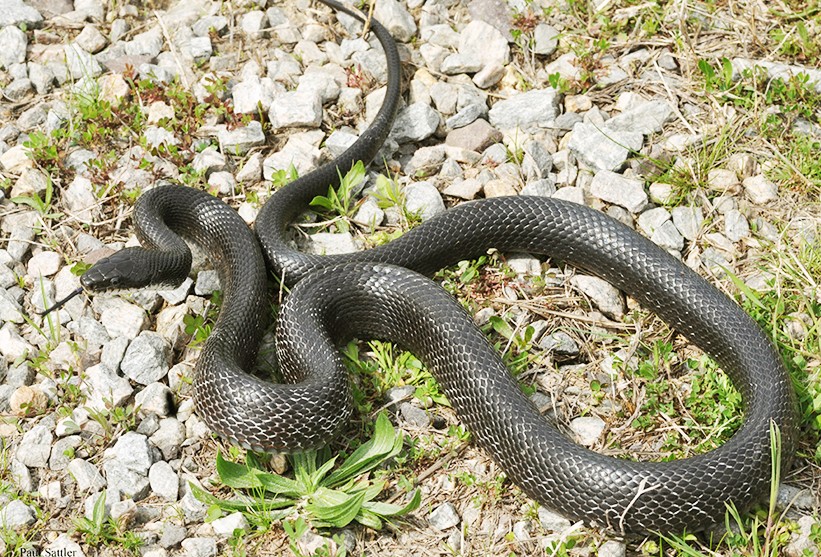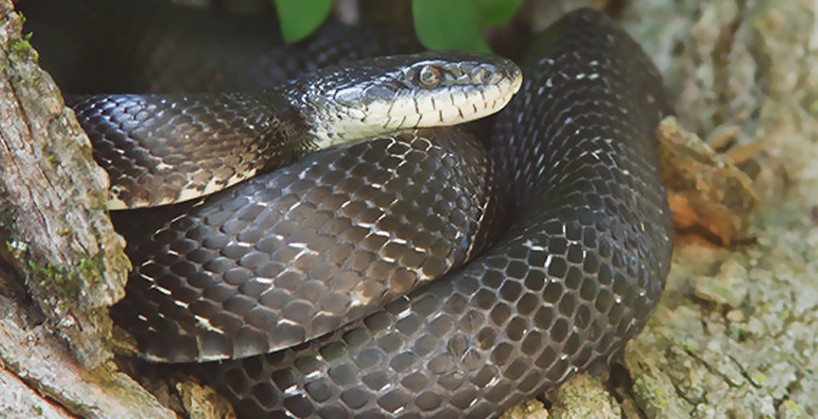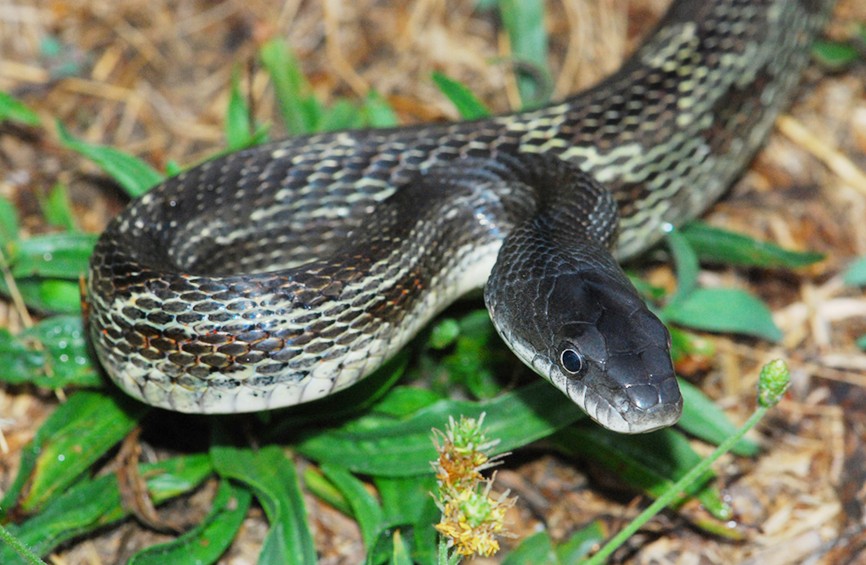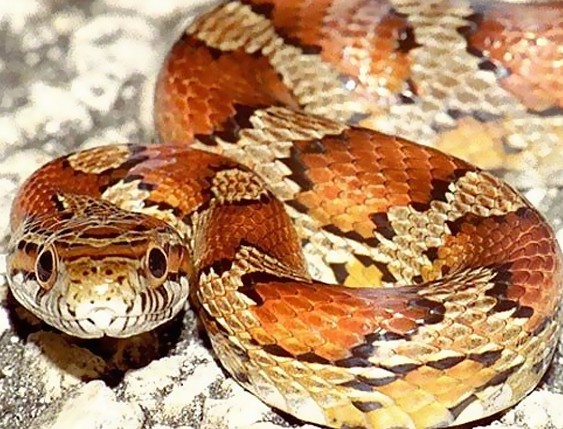Rat Snake

Picture of a rat snake
Introduction to Rat Snakes
The beauty of your home garden depends on how much care is given to the garden and your ability to combat the pests and put them under control. A garden that is continuously ravaged by pests will find it difficult or completely impossible to do well.
One of those pests that we find in our home gardens is the rat snake, a pest that is common in some US states, notably in South Carolina, New England, South Michigan, and virtually all Southeastern states, as well as other areas.
What does a rat snake look like?
To be able to differentiate between a rat snake and other snakes in your environment, there are features of the rat snake you must be conversant with. What are those features? Well, take a look at the following and you will be able to recognize a rat snake when you next see one:

Rat snake Size, Appearance and Identification
Head Shape and Pupils
Rat snakes have a small head that is similar to the head of a turtle in shape. They lack pits on their heads, and they have a small cap of scales with shiny appearance above the eyes (on top of the head). The pupils of their eyes are round, just like humans.
Teeth
Unlike poisonous snakes, black rat snakes do not possess fangs. Instead, they have several small teeth. The bite of a rat snake looks like a small scratch which is shaped like a horseshoe.
Body Characteristics
Rat snakes possess black scales on their backs with shiny appearances while their underside is lighter. Additionally, they have white throats and chins. When fully grown, an adult rat snake can measure up to 3 feet to 6 feet (91cm-183cm) in length.
Habitat
Rat snakes are widely distributed throughout all the Southeastern states and nearly all the Eastern as well as the Midwestern states up to Southern Carolina and New England.
The habitat is a little bit influenced by the species of the rat snake. For instance, the Piedmont and mountainous regions of Central Georgia and South Carolina are home to the black rat snake while the Southern Georgia and areas around the Savannah River in South Carolina are the natural habitat of the gray rat snake. The yellow rat snake, on the other hand, dwells mostly along the coast.
In general, rat snakes can be found in different habitats such as hardwood forests, rocky timbered hills, swamp margins, and river floodplains. They are usually found in barns and buildings that have been abandoned. Most times, they constitute the large snakes in built-up areas.
Are Rat snakes Poisonous?
Rat snakes are not poisonous. Though some rat snakes from certain regions are known to be a little aggressive than those from other regions, rat snakes generally are not venomous. For instance, yellow rat snakes that originate from the southern areas appear to be more aggressive than those from the northern. The reason why this is so is not known. However, scientists believe that variations in diets could be responsible for the behavioral differences.
The yellow rat snakes are also more aggressive during feeding periods. The baby yellow rat snakes bite faster than the adults especially when under threat, in self-defense. Additionally, the rat snakes in the wild are more defensive than those that are raised in captivity. Though these snakes kill and eat rats, their bites are not dangerous to humans.
Diet: What does a rat snake eat?

Picture of a rat snake eating a bird
As the name implies, rat snakes eat mainly rats in the home or gardens. Nevertheless, the snake’s diet is not restricted to rats alone; they also feed on mice, voles, chipmunks, birds, lizards, frogs and bird eggs.
While the young rat snakes eat mainly cold-blooded prey, the adults stick to majorly warm-blooded prey. Some species of rat snakes are referred to as chicken snakes due to their affinity for chicken eggs.
How does a rat snake kill their prey?
Rat snakes kill their prey by constriction. They swallow their prey after squeezing them to death. One way they achieve this is by squeezing the prey’s lungs so tight making it impossible for the lungs to function. This eventually overpowers the circulatory system making it impossible for blood to reach the brain thereby leading to the death of the prey. The prey mostly dies from ischemia within a space of a few seconds.
Besides, the rat snake can also break or crush the bones of the prey, which makes it easier to swallow a crippled animal. Sometimes, the rat snake continues to hunt even after killing its prey. They conceal themselves in the scent of the prey thereby making it difficult for other potential prey to detect their presence. They can kill more prey before returning to feast on the initial one. By so doing, they have several rats to eat in a single meal.
Rat snakes either wait for or ambush their prey. They also actively search for their potential meal.
Common species of rat snakes
Different species of rat snake exist in different areas. The various colors of rat snake include black, yellow, red and gray. However, the following are the various species you can familiarize yourself with:
Eastern rat snake/black rat snake (Elaphe obsolete Or Pantherophis alleghaniensis)

Picture of a Black Rat Snake
The Virginia Department of Game and Inland Fisheries notes that the eastern rat snake is primarily black, with a shiny appearance. It is possible to see a spotted pattern after this snake has eaten a meal or when it is stretched.
These spots are white, yellow, orange or red. Occasionally, the bellies are checkered in white, gray, yellow or brown. The young ones have white or grey bodies and are usually blotchier.
Texas rat snake (Elaphe obsoleta lindheimeri Or Pantherophis obsoleta lindheimeri)

Picture of a Texas Rat Snake
The coloration of Texas rat snake varies a bit by location. While the snakes in central Texas are yellower, the ones in eastern Texas are grayer. All Texas rat snakes have orange skin underneath their scales. Their bellies are gray or white while their heads are gray. They also have splotchy patterns. They can grow up to 6 feet in length.
Generally, Texas rat snakes are distributed throughout the whole of Texas, though they can also be found in areas like Arkansas, Louisiana, and Oklahoma. Their habitats vary and include grasslands, forests, urban and suburban areas.
Yellow rat snake (Elaphe obsoleta quadrivittata Or Pantherophis alleghaniensis quadrivittata)

Picture of Yellow Rat Snake
The most familiar rat snakes in the Florida peninsula are the yellow rat snakes. They are a morph of black rat snake/eastern rat snake, with orange or yellow coloring all over. Classically, these snakes have yellow irises and four barrow brown stripes that go down their backs.
Cincinnati Zoo has it on record that yellow rat snakes are common along the coasts of South and North Carolina, Florida and Georgia. Their main habitats include forests, flatlands, and shrubs, cypress swamps, citrus groves, buildings that have been abandoned as well as pastures.
Red rat snake (Elaphe guttatus Or Pantherophis guttatus)

Red Rat Snake Picture
Red rat snakes differ in color but usually possess orange or yellow bodies with dark marks on their bellies, large red blotches on their backs, and a V shape on their head tops. The term “red rat snake” is an outdated synonym for the corn snake.
Their major dwelling places are forests, mangrove swamps, pine flatlands, and urban areas.
Gray rat snake (Pantherophis spiloides Or Elaphe spiloides)

Picture of Gray Rat Snake
These make up the largest snakes in Canada, especially in southern Ontario, growing up to 7 feet long. They are usually colored gray with their backs and bellies containing dark gray or black blotches. The young ones have a vivid pattern which fades a bit as they grow older.
They are fairly distributed across the central United States: Indiana, Florida, and west to the Mississippi. They are mostly found in the forest but wander to grassy areas during warm weathers.
Reproduction
The male black snake is distinctively larger in size than the female and also attains sexual maturity faster. While the male reaches sexual maturity in about seven years, the female does so by about nine years.
The rate of growth rate, size and maturation rate of the rat snake are determined to a large extent by temperature and length of the active time of feeding.
Rat snakes lay eggs, just like the majority of the snakes out there. They start coming out of their winter hibernation from around March to May and then begin to look out for mates after a few weeks, communicating by making use of their pheromones. This takes place in late April, May, and early June. The males usually go out of their territories in search of receptive females and fight one another trying to establish supremacy.
It takes about five weeks after mating for the females to start laying eggs. Typically, they lay between 12 and 20 eggs under hollow logs or leaves, in their areas of hiding, or in burrows that are abandoned. It takes 65 to 70 days for the eggs to hatch. The number of eggs a female lays is directly related to her size as the females usually put a significant proportion of their body weight into eggs production.
The hatchlings eat voraciously and double their size fast. The females are occasionally able to produce two clutches of eggs a year if conditions are favourable. Being iteroparous (having repeating reproductive cycles), mating in rat snakes is repeated about the same period each year.
Are rat snakes good to have around?
Rat snakes are one of those colubrid snakes that you can keep as pets. The most popularly kept rat snakes are the black snakes. They can grow to about 3 to 8 feet long and live 10 to 30 years in captivity. Since the snake feeds mainly on rat and other rodents but hardly causes any harm to man, it is safe to say that one can keep rat snakes as pets.
How to get rid of rat snakes from your garden?
It is quite easy to get rid of rat snakes from your home or garden. All you need to do is follow these steps:
Since snakes often look for damp hiding places, keep a damp burlap sack in those hiding places and check it often to see if the rat snake has gone in. If the snake enters the burlap sack, put on your work gloves, then pick up the sack and quickly take it outside. Be careful so as not to be bitten by the snake, though their bites are not poisonous. If there are openings in the former hiding place, seal them up immediately. If you need to move the snake immediately, proceed to the next stage.
Get a bucket that is over 5 gallons large, a rake or broom and carefully sweep the snake into the bucket. Move the snake to wherever you wish to take it to and release it. When you return, close up the den.
Make sure to remove from the environment any food capable of attracting rat snakes back to the place. Remove all stone piles, leaf piles and food spills. Close up all openings or cracks in windows, basements and under decks.
Interesting Fun Facts
- Rat snakes are well admired and can easily be obtained in the pet trade, with virtually all species doing well in captivity.
- The male rat snakes are usually larger than the females. The females devote a high proportion of their weight to egg production.
- Rat snakes do not only eat rats; they also eat other small rodents.
- All species of rat snakes can swim brilliantly.
- Some of the predators to rat snakes include humans, hawks, racoons, and bobcats.
- A black rat snake can easily fool its potential predators by vibrating its tail to look like a rattlesnake.
- Newly hatched rat snakes measure about 12 inches in length.
- Rat snakes are commonly found in North America, Central America, and Southern Canada.
- Rat snakes can emit pungent odour to scare off their predators when touched.
FAQ’s
How to identify a rat snake
The head of the rat snake is shaped like that of a turtle, and they have a small cap of scales with shiny appearance above the eyes but usually have no pits on their heads. They have round pupils and also have several small teeth.
They have black scales on their backs with shiny appearances while their underside is lighter in color. Besides, their throats and chins are white.
How big does a rat snake get?
They grow up to 3 – 7 feet long
How long does a rat snake live?
They live up to 10-15 years in the wild, but with a good diet, they can live up to 30 years in captivity.
Do rat snakes eat other snakes?
Rat snakes do not eat other snakes. Instead, they occasionally hibernate with other species of snakes.
Do rat snakes have fangs?
No. Rat snakes don’t have fangs because they are non-venomous. Only venomous snakes possess fangs. Rat snakes possess several small teeth.
Are rat snakes poisonous to dogs?
Though their bites can cause some discomfort, rat snakes are usually non-venomous. So, they are not poisonous to dogs or other pets.
Conclusion
Rat snakes can be beneficial to us in some ways. For instance, they help reduce the population of rodents around your home and gardens. But, unfortunately, they feed on eggs and as such, can easily reduce the population of your poultry birds thereby leading to economic loss.
The snakes can as well be kept as a pet since their bites are not poisonous. Getting rid or keeping the snake depends on what you make of it.
